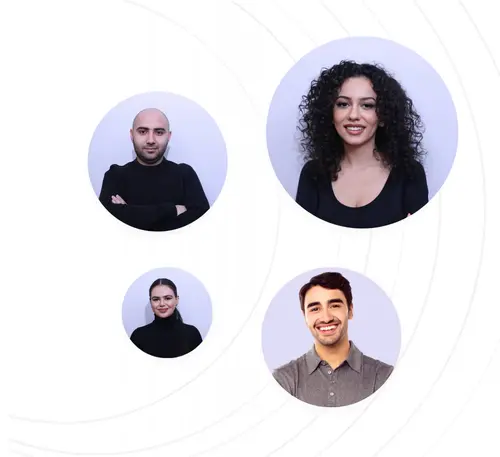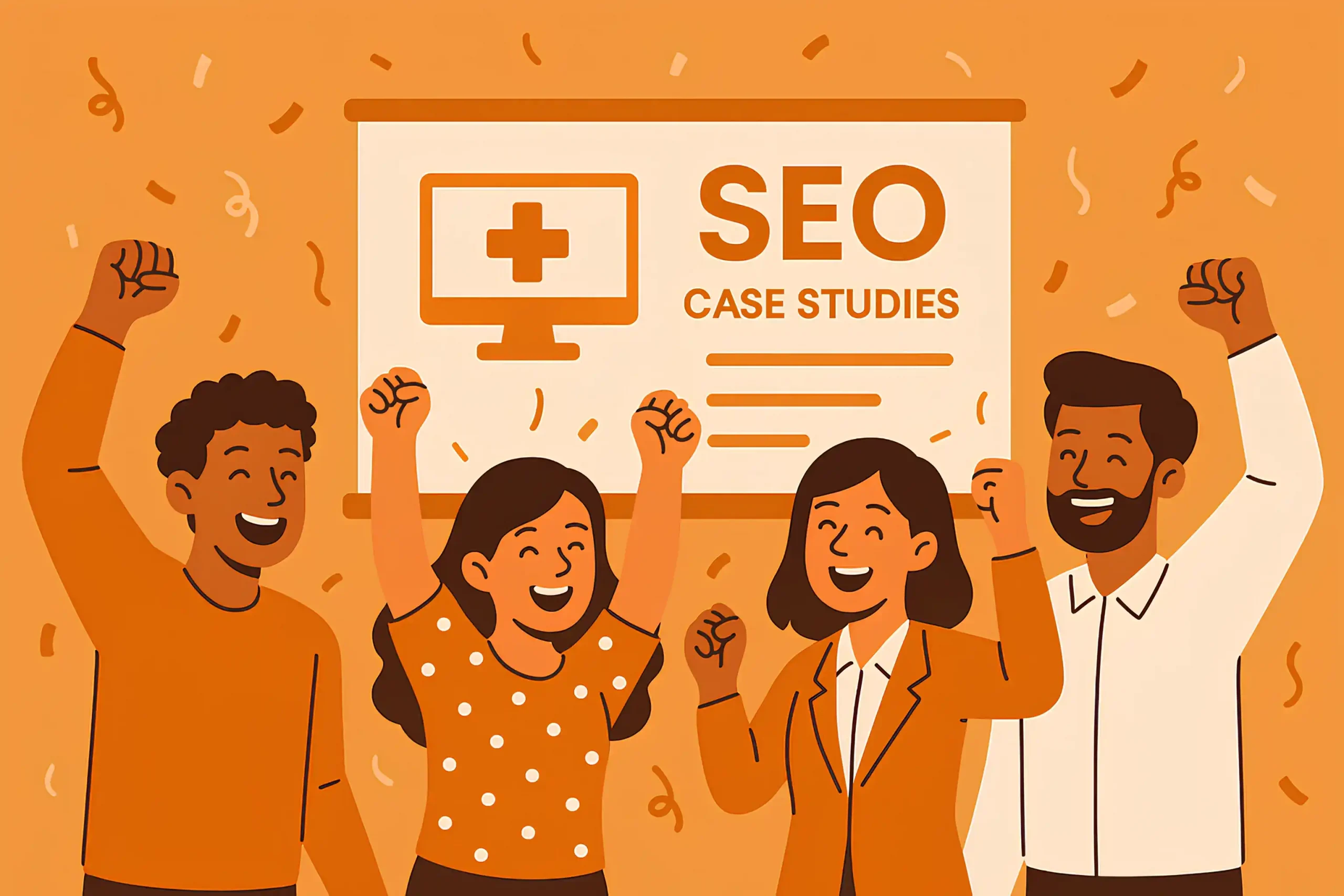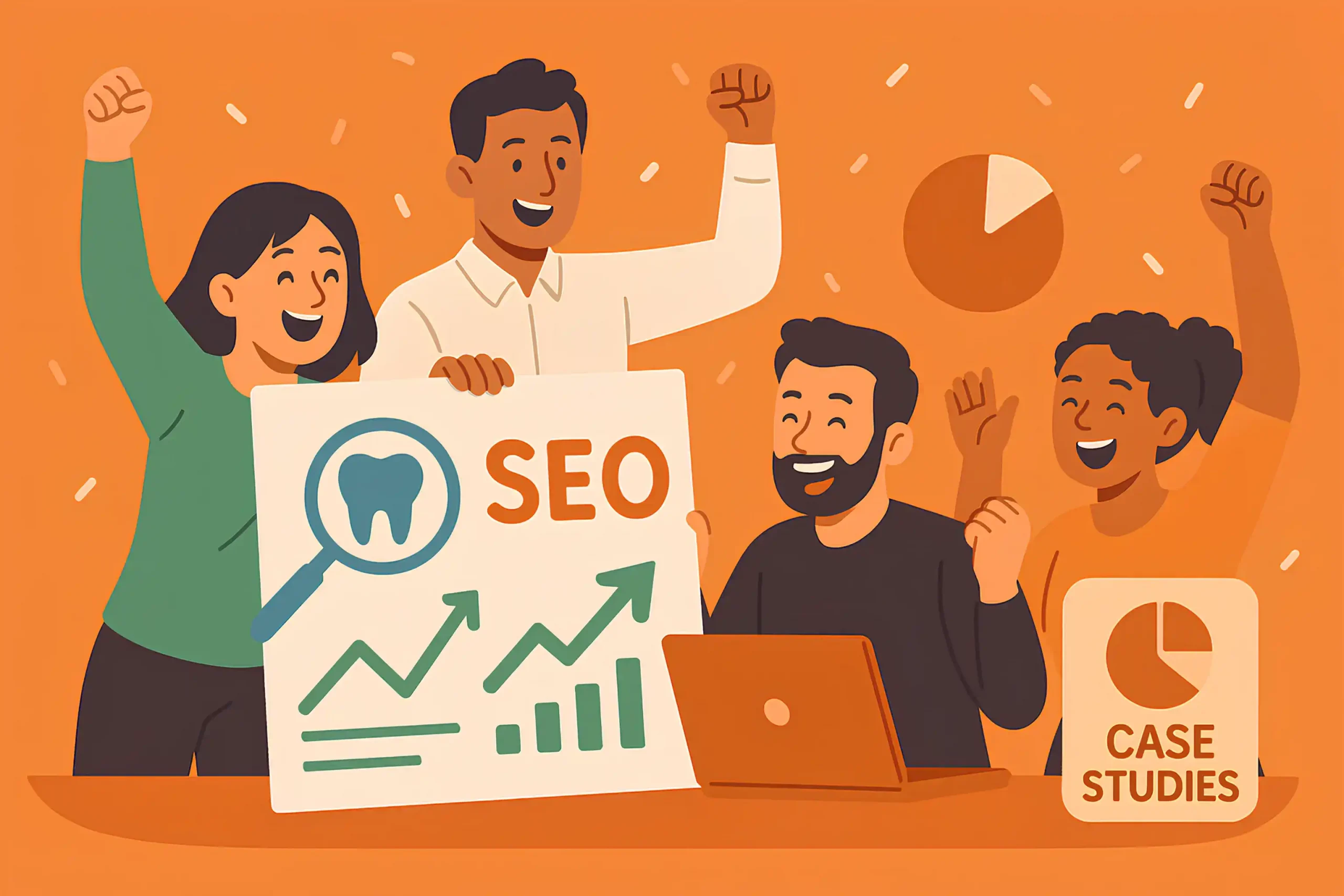Updated November 16, 2025
10 eCommerce SEO Case Studies: Real Results From Hands-On Work
Is there an SEO expert who doesn’t enjoy eCommerce SEO? I honestly doubt it. Our team isn’t any different. Over the years, we’ve handled dozens of eCommerce SEO projects: some smooth, some painful, and a few that tested every bit of patience we had.
We’ve seen unexpected wins, frustrating plateaus, and those moments where you fix one issue only to discover ten more hiding behind it. But every setback taught us something, and those lessons shaped the way we approach eCommerce SEO today.
So in this post, I’m going to personally walk you through 10 of our eCommerce SEO case studies. Real stories, results, and mistakes we had to learn the hard way. If you’re running an online store and want similar outcomes, feel free to reach out to our eCommerce SEO agency. Ready? Let’s jump in.
1. Shopify SEO Case Study: 300% Organic Traffic Growth In 7 Months
In April 2025, we started working with an online headstone store called Signature Headstones, built on Shopify. I’ll be honest with you; the niche looked simple at first. Barely any competition, very slow SERPs, and keywords that didn’t require a war to rank.
But the first three to four months were… quiet. Too quiet. No meaningful traffic movement, no real lift across the core pages, and definitely nothing that would make a Shopify store owner excited about SEO.

The client was understandably frustrated and wanted to end the project, and trust me, I understand; nobody likes paying for months when the graphs don’t move.
We asked him to stay patient for just a bit longer.
By month six, everything clicked. Organic traffic shot up 300%+, the store began receiving qualified leads, and the brand started appearing in AI Overviews and LLM-generated answers for its main keywords.

Our Classic Approach
We kicked things off with a classic, straightforward SEO process; the same approach we use when we want to understand what we’re dealing with before getting creative.
The first step was a full SEO audit. We needed to assess the site’s actual health, address crawlability issues, make sure everything is indexable, and clean up any content that could waste crawl budget.
Once we got under the hood, we found over 50+ blog posts; most of them were unrelated or competing with one another; massive cannibalization. The same issue existed on the collection pages, so we went back to the basics: keyword research, proper targeting, and organizing each page around its own clear intent.

From there, we rebuilt the structure. We created new collection pages for long-tail opportunities (10+ pages that didn’t exist before), reorganized old content, and made the entire website feel more “understandable” for users and search engines.
Once the foundation was in place, we moved to content. Our team created more than 30 new blog posts, going after both bottom-of-the-funnel topics and broader funeral-related searches.
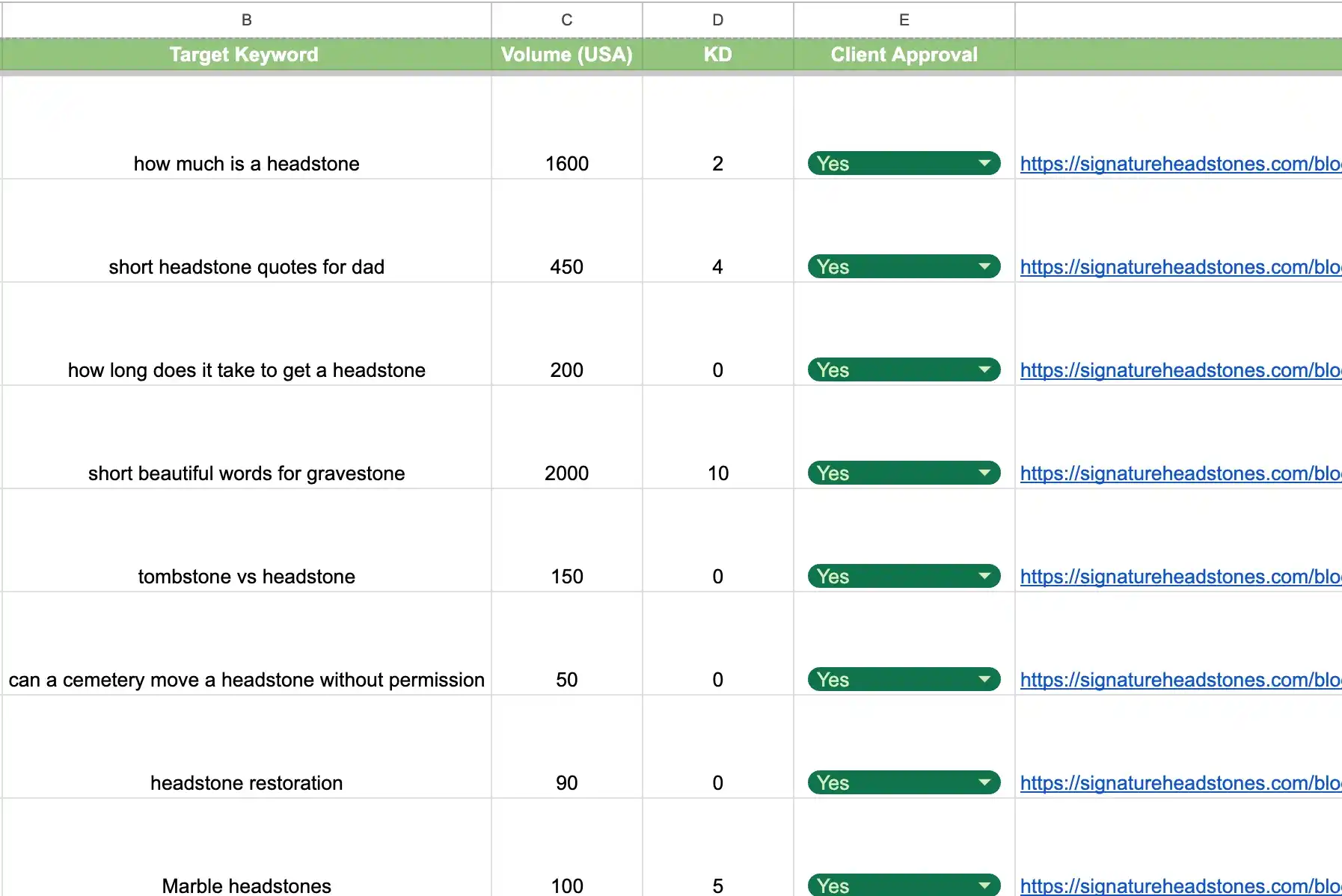
These were not directly about headstones, but they generated highly relevant informational traffic: cost guides, timelines, common challenges, what to do if you can’t afford certain services, and so on.
Within three months, the on-page SEO foundation was solid. Strong internal links, fully optimized collections, clean technical setup, and a content base that supported the product pages.
In parallel, we ran a consistent eCommerce link-building campaign. Zero PBNs, zero link farms. Only real placements from strong publishers and niche-relevant blogs.
Over the course of seven months, we secured approximately 100 high-quality backlinks, and we continue to build more today.
The client couldn’t be happier, and we’re still working together to push things even further.
Also explore: 10 Link-Building Case Studies from My Own Campaigns
2. eCommerce Growth Story: 0 to 100K with a Smart Content Strategy
Honestly, this is one of our SEO agency’s most successful eCommerce SEO stories. In the middle of the project, the client decided to change the entire domain. If you’ve ever managed a migration for an eCommerce site, you already know it’s stressful, it’s risky, and it’s the type of thing that can turn a great campaign into a disaster overnight.
Just between us… I hate migrations. I’ve done many of them, but they never stop giving me anxiety. Still, it’s part of SEO, and when a client needs it, you can’t run away from it. So we went all in and handled it with extreme care, and thankfully, we kept every ranking intact.

This project was an online store specializing in cat food products. Their internal team was responsible for off-page SEO, digital PR, and link-building (with a limited budget), while our team took full ownership of the SEO content strategy and the overall organic growth.
We started working together more than two and a half years ago, and the growth has been consistent, steady, and, honestly, one of the most rewarding journeys we’ve had with an eCommerce client.
The domain migration could’ve derailed everything, but instead, it became one of the strongest proof points of our technical and content-driven approach.
Today, I’m really happy to walk you through what we did, what worked, and how we managed to keep the progress even after switching domains.
How We Started
When we first took on this project, we began with a deep competitor analysis. Frankly, the U.S. market surprised us. There were many players in the cat food and pet niche, but none of them had a fully developed content strategy.
Nobody had covered the industry from every angle with real depth. That made our job easier: the gaps were everywhere, and the client had a solid SEO budget for an aggressive content strategy.
We built the foundation around four core pillars where our CEO had strong subject-matter knowledge: cat nutrition, cat behavior, cat health, and cat breeds.
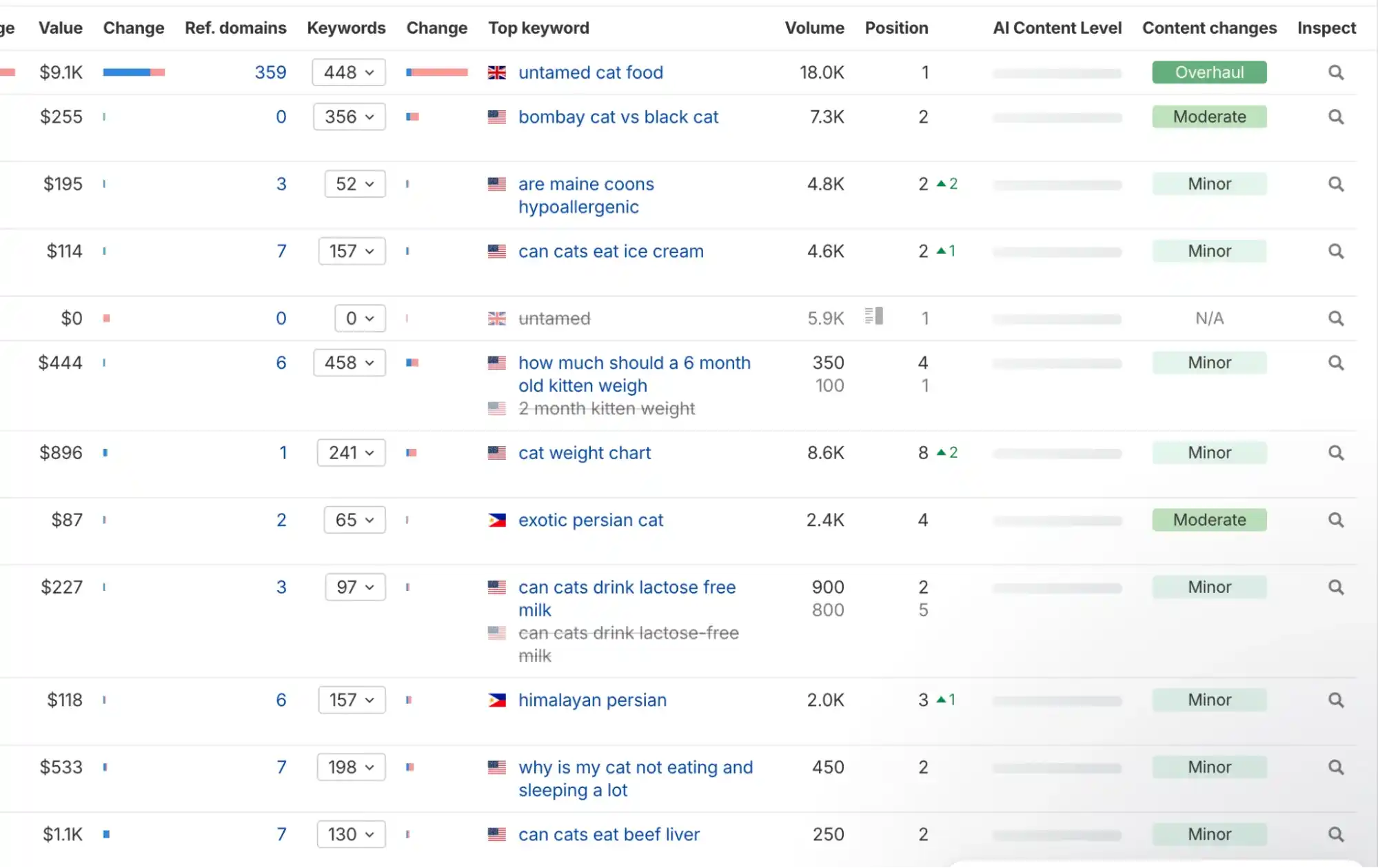
Once we mapped everything out, we crafted more than 400 content opportunities, all tightly connected, relevant, and based on real search data.
Over the next 10 months, we published content at scale. More than 400 blog posts were created, each one internally linked with purpose, each one written and reviewed with Google E-E-A-T in mind.
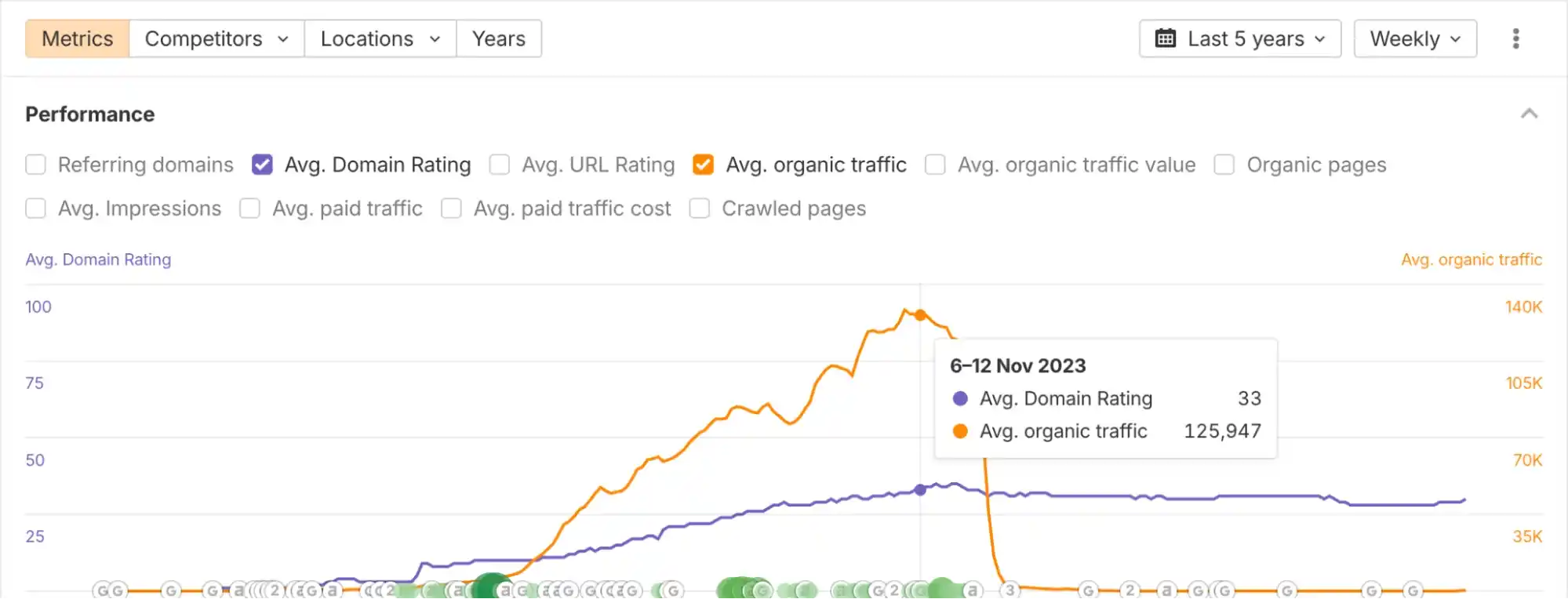
Within the first year, the results were what we hoped for. We went from almost nothing to 100K monthly organic visitors, and almost all of that growth came from the blog posts we’d been publishing nonstop.
But then came the painful part. Right when everything was working, the client decided to shorten the domain, which meant a full migration, and as you know, migrations can destroy months of progress if something goes wrong.
Still, we pushed forward. Below is the screenshot after the migration:
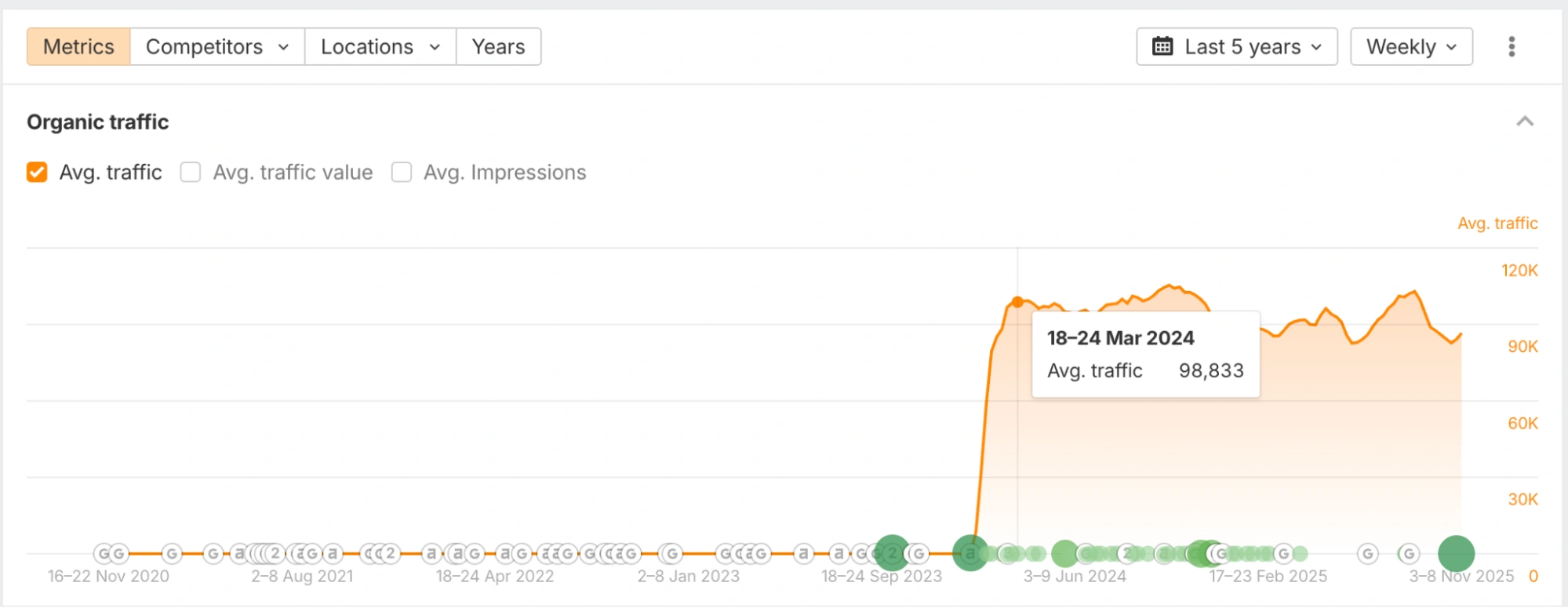
After the migration, we monitored everything daily. Rankings, crawl patterns, indexation issues, internal links, every detail.
The good news is that within a short period, we regained almost all of our positions. The new domain stabilized faster than we expected.
We had a 10-20% traffic dip, which is completely normal during a migration of this scale, but nothing dramatic. More importantly, we protected the entire foundation we had built earlier.
That’s the part I’m most proud of. It’s one thing to grow a site from zero to 100K monthly visitors. It’s another thing to migrate a domain during that growth, and still keep the progress without breaking anything.
This became one of those eCommerce SEO projects our team talks about often, simply because the risk was high and the execution paid off.
If you want similar results or if you’re planning a domain migration and don’t want to lose your hard-earned rankings, you can consider our SEO migration services, and we’ll help you handle it safely.
3. eCommerce SEO Case Study for a Canadian Weed Store
About three years ago, I came across this project on Upwork while freelancing. Like many other opportunities back then, I took it, gave it a try, and it turned out to be one of those smaller eCommerce projects that brought good results.
To be completely honest, this one was in the cannabis niche, and I’m not a huge fan of doing SEO in that space. It’s not because it’s bad or boring; it’s just that the restrictions make it harder to do SEO the way I like to do it.

You can’t go too aggressively with link-building, digital PR is tricky, and paid channels are off-limits in many cases. I usually prefer having the freedom to utilize every growth opportunity: content, links, PR, collaborations, and so on.
However, we still decided to focus purely on what we could control. I kept the strategy clean, realistic, and completely organic. Despite the limitations, the campaign started performing surprisingly well.
The Framework We Followed
Let’s skip the usual part. Of course, we handled all the core SEO work: technical cleanup, on-page optimization, internal links, metadata, the whole package. Since our team has deep experience with WordPress SEO (WooCommerce), we made sure everything was technically flawless from the start.
So, what really had the highest impact?
We started with in-depth keyword research, focusing on the long-tail, highly relevant terms that competitors weren’t even touching.
For example, instead of having one single collection page for cannabis, we found and created more than ten collection pages for various strains from Sativa to Indica.

Next, we analyzed every product individually, prioritized them based on keyword potential, and fully optimized each page, from metadata and copy to the on-page structure and internal linking.
Every product page became its own landing page, designed to inform, convert, and signal relevance to search engines.

I think that’s what gave us the real edge. Most eCommerce sites in this industry ignore product-level eCommerce SEO. Instead, they treat collections as the main traffic drivers.
You might find this useful: SaaS SEO Case Studies
What Their Team Covered
One interesting part of this project was that the client’s internal team handled all the content writing, not us. When we started back in 2022, they were already using AI tools to produce blog posts, and by now, I can see they’ve published over 1,000 articles.
To be honest, most of it is low quality. No structure, no editing, no real human touch; just fast, AI-generated content that you can spot from a mile away.
If this were a SaaS or finance project, I can almost guarantee it wouldn’t work. But despite all that, nothing bad happened. In fact, some of those low-quality posts are performing really well, especially the bottom-of-the-funnel ones that answer very specific product or purchase-related questions.
They didn’t do any link building either. Over time, they naturally picked up a few random backlinks; mostly low-quality citations and a handful of spammy links,
What Happened Next
From almost nothing, the site grew to around 20K monthly organic visitors within months, all from organic search. It was a solid win for such a restricted niche, especially considering there was no real link-building strategy and the content quality wasn’t what I’d call “Google-worthy.”
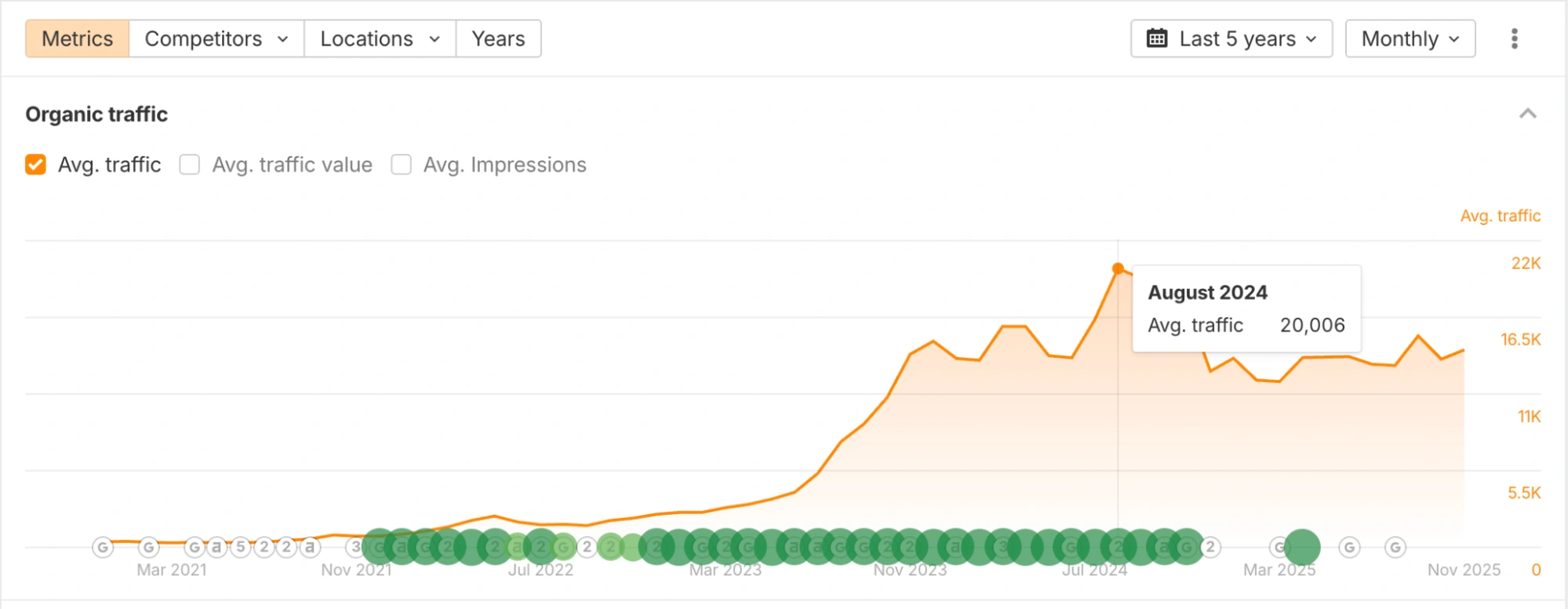
After a while, the client decided to move everything in-house; they built their own team and continued from there, which I totally respect. But just out of curiosity, I checked their performance a few days ago, and something interesting stood out.
When I looked at their AI search visibility (LLMs and AI overviews), there was nothing. Zero traffic, and it actually made sense. The type of content they have might still work fine for traditional search, but AI-driven engines are far less forgiving.
They expect quality, context, and depth; things only real expertise and human editing can bring.
So this project is a great example of how traditional SEO and AI search visibility are becoming two very different worlds. You can still dominate Google with average content in certain markets, but that same content won’t even appear in AI-driven results.
If you’re searching for reliable Cannabis SEO services, we’d love to help. Contact us today.
4. Traffic Recovery for an Enterprise eCommerce Store
Boom and Bucket is one of our favorite long-term eCommerce SEO projects. We partnered with them a few years ago and helped the brand grow its organic visibility, keyword portfolio, and overall authority across the competitive equipment and machinery niche.

But earlier this year, things changed. Their traffic started dropping, not drastically, but enough to make them reach out again and ask us to take a deeper look.
I don’t want to go through the whole history of how we built their SEO foundation a few years back. Instead, I’ll focus on the most important part: how we managed to recover their traffic and the unique techniques we used to bring them back on track.
Client Success Story
When they reached out, the first thing we did was start an in-depth investigation to understand what caused the drop. After digging through analytics and timelines, it didn’t take long to see the pattern.
It made sense. Most of the traffic loss came from blog posts, not the main commercial pages. These were articles that had performed well for months but were now getting hit because they weren’t aligned with the new “usefulness” signals Google started emphasizing.
So, we rolled up our sleeves and went straight into recovery mode.
First, we optimized all the blog posts that had lost traffic; rewriting sections, improving depth, and adding E-E-A-T elements. We made sure every piece was data-backed and valuable to readers, not just well-optimized for keywords.
Next, we looked at internal linking. We added fresh internal links from high-authority pages, especially those with strong backlink profiles, to the articles that had dropped.
This helped transfer link equity to the weaker pages and balance the overall topical strength.
We also added the most important blog pages (the ones hit hardest) directly into the footer to ensure they received more crawl attention and homepage-level authority.
I know, this may sound simple, but it took weeks of deep analysis and manual work to get everything right, from content structure to anchor text adjustments.
Within a few months, we started to see a clear recovery curve. Traffic began to rise again, keyword positions returned, and many of the previously affected pages even surpassed their old performance levels.
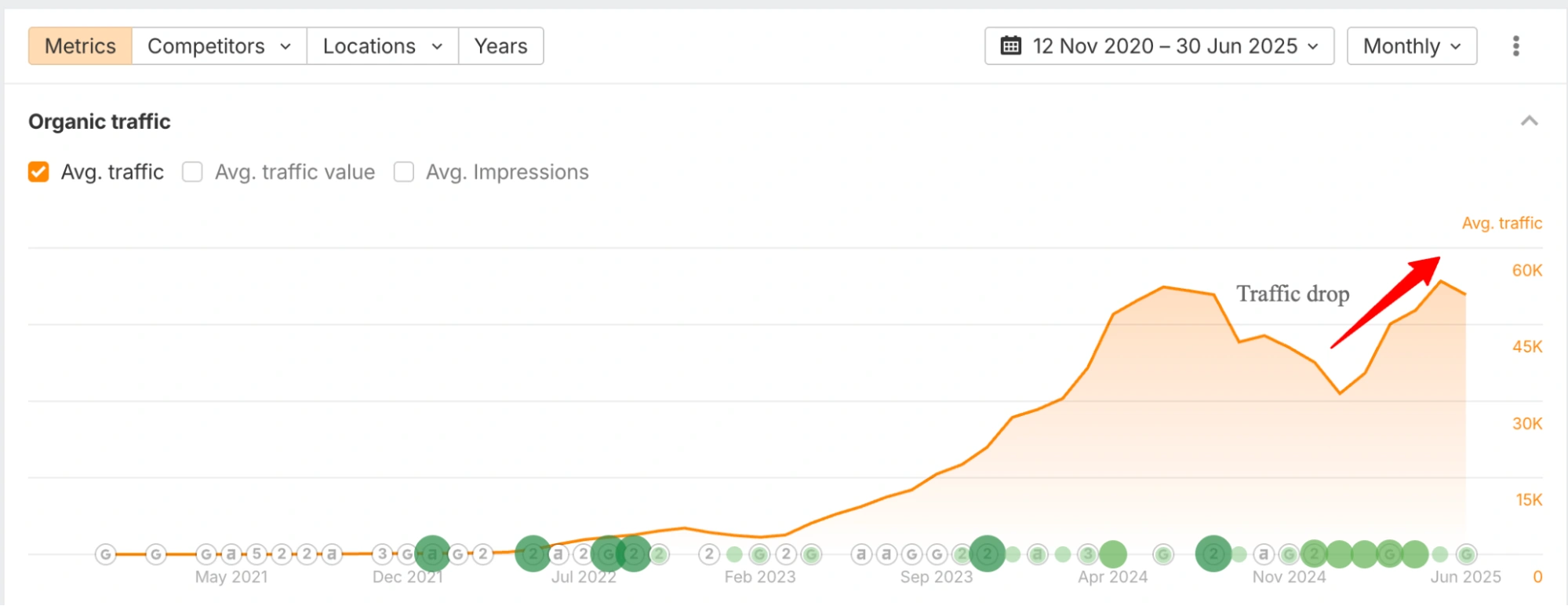
But I want to be completely transparent with you here. When a traffic drop happens, especially after a Google core update, it doesn’t always mean you’ve done something wrong. Sometimes you can audit everything, check every metric, every piece of content, and realize that nothing is actually broken. In those cases, the best move is not to panic.
SEO is often about timing and patience. If your foundation is solid and your content helps users, Google tends to readjust over time. That’s what happened here: part recovery through strategy, part natural rebound.
If you’re running an enterprise eCommerce store and facing similar issues after an update, feel free to reach out to our enterprise SEO agency. We’ve been through dozens of recoveries like this, and sometimes, all it takes is a fresh pair of experienced eyes to see what’s really going on.
5. The Reality Behind an eCommerce SEO Campaign That Didn’t Move
Not every case study is a success story, and I think it’s important to say that out loud. In SEO, not everything you touch turns into growth charts and screenshots with upward arrows. So in this case study, I wanted to share one of those projects that didn’t go as planned.
The project was for All Filters, a B2C eCommerce brand selling water filtration products. We came in with a clear strategy, a good plan, and honestly, the same energy we bring to every campaign.

But despite months of consistent work, this one just wouldn’t move the way we expected.
I think every SEO agency has at least one project like this, where you do everything right, follow all the best practices, and still don’t get the results you hoped for. It’s frustrating, but it’s also one of the best reminders of how unpredictable SEO can be.
So, let’s talk about what happened and what we learned from it.
What Happened Next
We worked on this project for about six to eight months, and honestly, we gave it everything. To give you a full picture of what we did, we started with a deep technical and on-page SEO audit, analyzing every detail from crawl budget usage to indexation, performance, and site health.
We didn’t rely on just one tool either. We used Ahrefs, Sitebulb, Screaming Frog, and multiple speed optimization and diagnostics tools to make sure there were no hidden issues.
By the end, the site was in near-perfect technical condition, except for one big problem that, in my opinion, was the real reason the project never took off.
On paper, it looked like more pages, more potential visibility. But in reality, it created massive duplication and crawl inefficiency. Search engines couldn’t clearly understand which product was the main one, and the site’s authority was spread thin across thousands of near-identical pages.
We tried to explain it multiple times, but the client was confident in their structure and didn’t want to make any changes (At least adding canonicals).
So, we moved forward with what we could control.
We began a link-building campaign and eventually convinced them to try HARO link-building as well. Within eight months, we built roughly 100 backlinks, including over 30 high-quality HARO links with an average DR70+; all from real, relevant home improvement and product-related publications.

We had the technical setup in great shape, a clean backlink profile, and some of the best topical content in the industry, but still, the needle didn’t move. No traffic spikes, no sudden jumps in keyword rankings, just stable, flat metrics month after month.
Even now, I occasionally check in with the owner, and it’s still the same story.
They’ve since hired other agencies, and despite new strategies and adjustments, the traffic graph hasn’t changed much.
This project taught me one of the most important SEO lessons again; sometimes, you can do everything right, but if one core issue (like site architecture) isn’t fixed, nothing else will matter.
So if you’re reading this and happen to be the best SEO agency in the world, you’ll probably recognize this project, and you’ll agree that no matter how strong your tactics are, a flawed foundation can hold everything back.
By the way, if you’re looking for HARO link-building services, we can help you secure top-tier PR backlinks for your eCommerce store.
6. How We Recovered a Shopify Store After a Major Traffic Drop
Last year, a handmade leather goods store reached out to us after experiencing a major traffic drop. Practically overnight, their organic traffic went from around 150K monthly visitors down to about 90K; a huge hit for a Shopify store that had been performing steadily for years.
Our mission was clear: find out what caused the drop and recover the lost visibility. To be honest, this kind of project is always tricky, because sudden declines like this usually don’t come from one simple issue.

It’s rarely “one broken page” or “one bad backlink.” It’s often a mix of small technical issues, outdated content signals, and algorithmic shifts all hitting at once.
So, we started a full investigation to uncover what really happened and how we could bring the traffic back.
What Followed
You might think we started from zero: a full-blown technical audit, fixing canonical issues, resolving content cannibalization, and all that. But no, not this time.
Of course, we still ran a detailed technical and SEO audit to make sure we weren’t missing anything, but surprisingly, everything looked fine. The site was healthy; no crawl issues, no indexing problems, no technical red flags.
The store already had an in-house SEO team, so their on-site setup was in decent shape. But what we found next was way more interesting.
After digging deeper, we discovered that around 90% of their old backlinks built a few years ago had either been penalized or lost their authority. Many of those links came from PBNs, low-quality directories, and other cheap sources that were once “working,” but over time, got devalued or dropped from Google’s index entirely.
Honestly, this is a very common story. In-house teams or small agencies often go for quantity over quality when it comes to link-building. It works for a while, until Google tightens the filters and the site’s authority collapses.
We also wrote about: Healthcare SEO Case Studies
We also noticed that the traffic drop was mostly on collection and product pages, not blog posts. That immediately told us the issue wasn’t content-related; it was authority-related.
So we focused our entire effort on rebuilding that authority. Over the next few months, we secured 30+ high-quality backlinks, mainly from listicle-style articles and homepage mentions on relevant lifestyle, fashion, and product review sites.
The results came fast. Within a few months, the traffic curve started going back up. The store regained its rankings across major money pages, and the overall visibility stabilized again.

It wasn’t a complicated fix this time; just smart, targeted link-building that restored the trust and authority signals the site had lost. Sometimes, recovery really is that simple.
7. From 0 to 30k Organic Visitors but Zero Sales (What Went Wrong)
One of our old clients is the kind of person who loves starting new projects in different industries, but rarely sticks around long enough to see them fully through.
A few years ago, he decided to launch his own teeth whitening eCommerce brand, NatruSmile, selling whitening kits and related products.
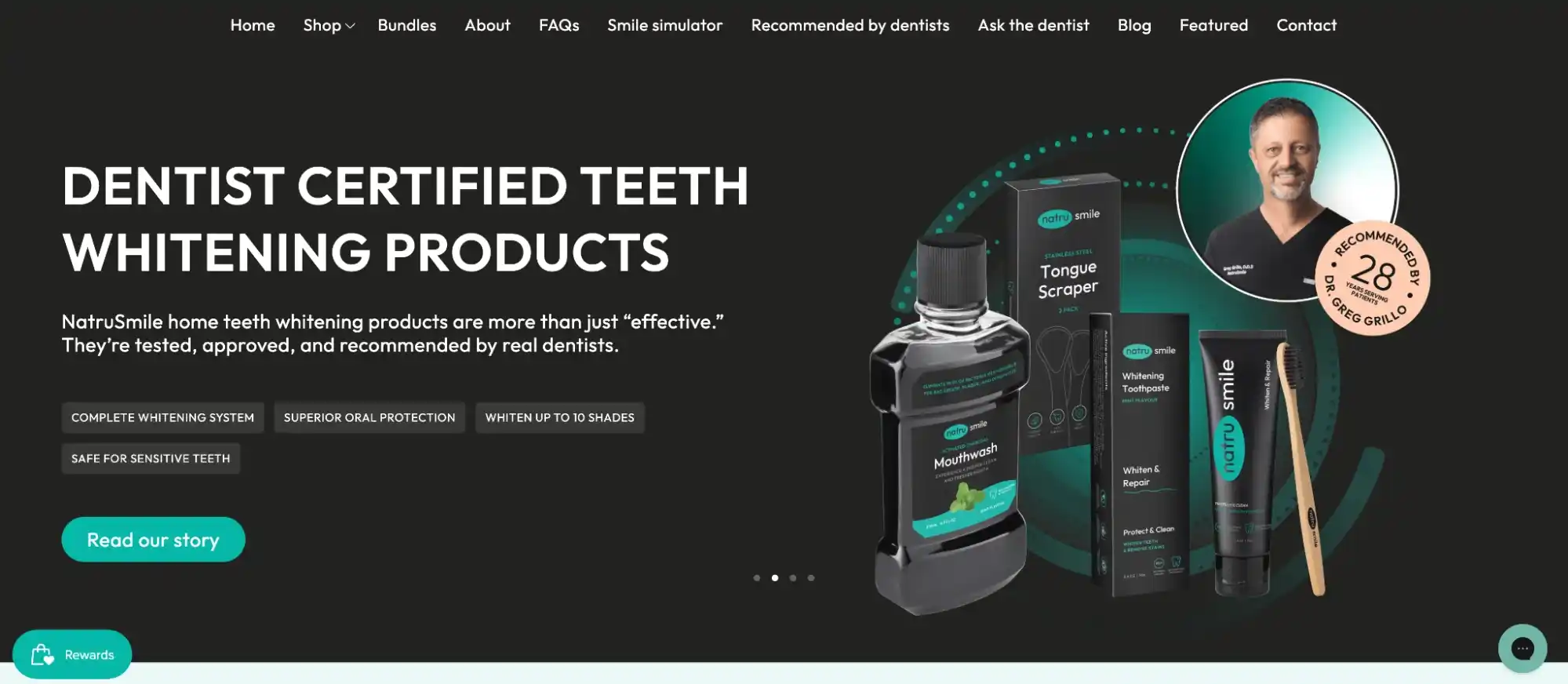
Because we had already worked together on several successful projects, he didn’t hesitate to trust us again.
We handled everything: site design, technical setup, keyword research, content outlines, copywriting, and the full SEO foundation.
The results looked great on paper. Within 12 months, we grew the site from zero to around 30K monthly organic visitors: solid, steady growth for a new eCommerce brand.
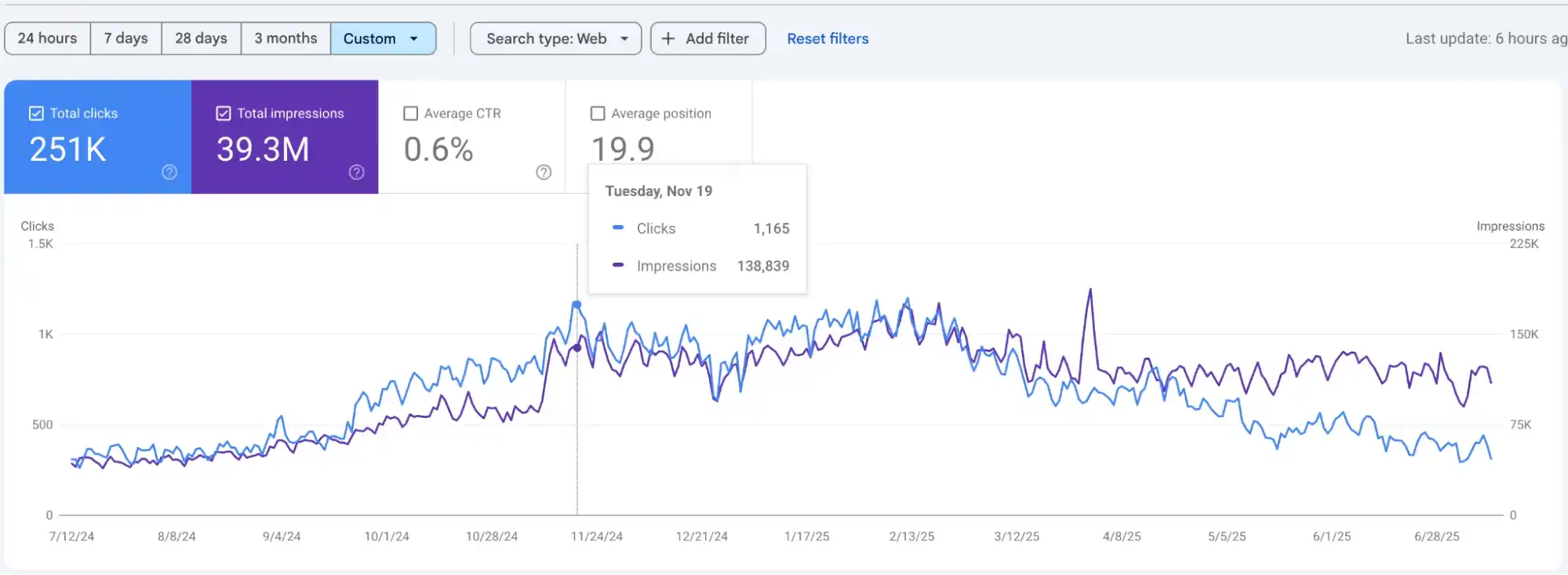
But there was one big problem.
Almost no sales.
So, let’s break down what went wrong, because this one became a real eye-opener, even for us.
Behind the Scenes
As I mentioned, we set up everything from the ground up: the full SEO foundation, proper structure, metadata, content strategy, and copywriting. I’ll skip the generic setup details because that’s standard in almost every project.
The first major challenge was that, unlike most eCommerce stores with hundreds of products, this brand only had ten.
Ten core products in total. That meant we didn’t have the scale advantage; no massive catalog to target wide keyword variations or long-tail search intent. So every single page had to pull its own weight.

The second challenge was the competition. We weren’t just competing with other teeth whitening brands. We were going head-to-head with major healthcare publications and authoritative platforms like Amazon, Good Housekeeping, and Healthline.
Look at here:
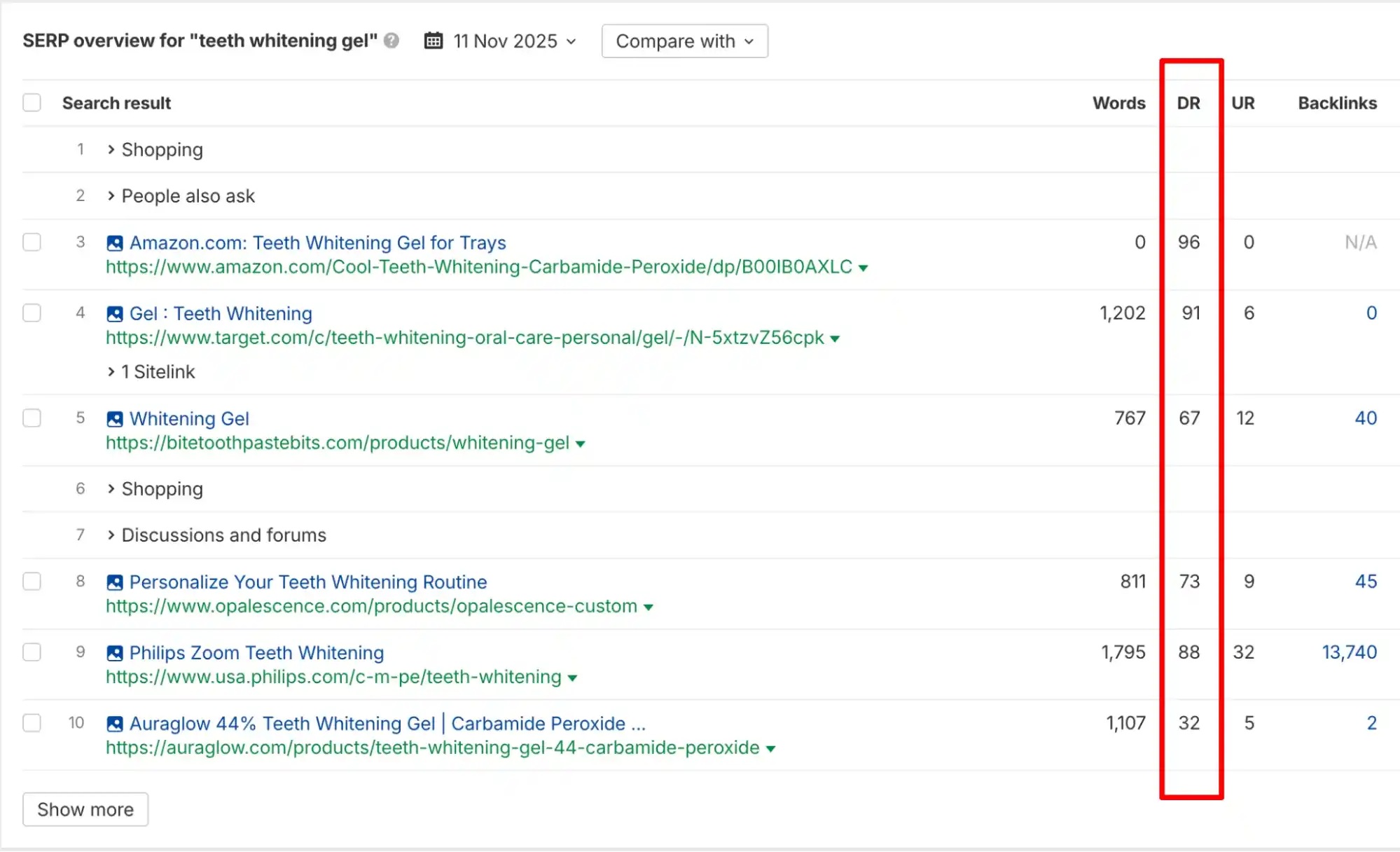
These weren’t even direct eCommerce competitors; they were ranking with affiliate listicles and “best teeth whitening products” roundups. Competing against such a domain authority is tough, especially for a new brand.
Still, we moved forward with a strong content-led strategy. Over 12 months, we published more than 250 high-quality blog posts, each reviewed and approved by a retired medical dentist to reinforce E-E-A-T (Experience, Expertise, Authoritativeness, and Trustworthiness).
The internal linking was tight, the content had real depth, and we made sure every article had clear topical relevance to our products.
At the same time, we launched a link-building campaign, earning backlinks from lifestyle, healthcare, and consumer review sites to strengthen the brand’s domain authority.
What Happened Next
Within 12 months, the content strategy started to deliver results; the website was generating over 30K monthly organic visitors, which was a great number for such a small eCommerce site.
However, around 95% of that traffic came from blog posts MOFU and TOFU topics), not from the product or collection pages that convert.
We had all the CTAs in place: banners, internal links, product callouts; everything that should’ve helped move visitors from content to checkout. But it didn’t happen.

The store barely made sales, and the profit margin stayed weak because of two simple but powerful reasons: the market was extremely competitive, and the product range was too limited to scale.
At that point, our advice was clear; if the client really wanted to compete with brands like Healthline or Good Housekeeping, they needed high-authority backlinks from reputable healthcare publications.
That’s what HARO link-building can achieve, and it’s one of our strongest areas of expertise. But unfortunately, the client decided not to move forward with that investment.
8. B2B eCommerce SEO Case Study: From Zero to Market Leader
This is one of our most successful eCommerce SEO projects to date. The client, A1SolarStore, specializes in solar and home energy solutions: panels, batteries, inverters, and full energy systems for residential and commercial use.
When they came to us, their organic visibility was practically non-existent. We started from scratch, building the SEO foundation, planning the structure, optimizing every category and product, and developing a long-term content and link-building strategy.
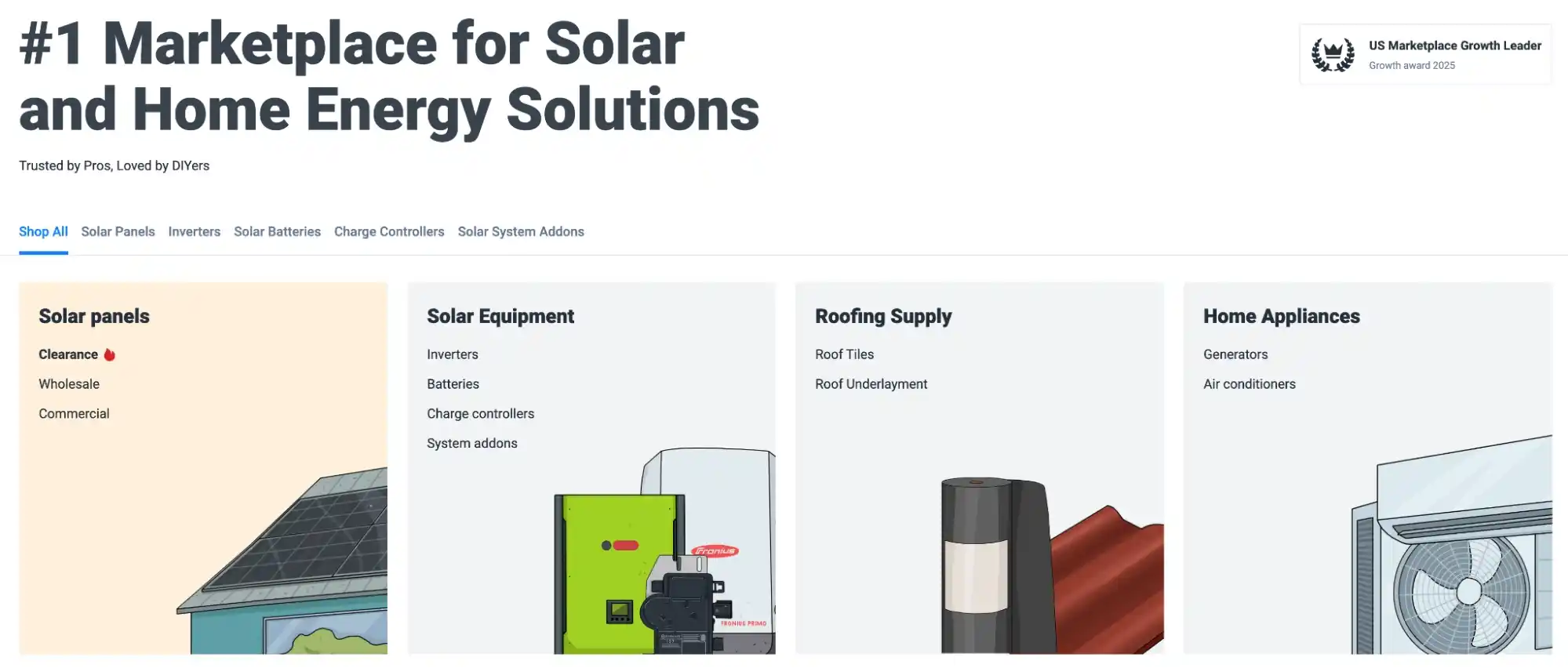
Within just over a year, the website grew from 20k to more than 100k monthly organic visitors, becoming one of the leading online solar retailers in the U.S.
You might wonder why I’m calling this a B2B eCommerce case study when the site also serves a large B2C audience. It’s a fair question, because the truth is, A1 Solar Store is both.
Roughly half of their traffic and customers come from individual homeowners researching solar systems, while the other half includes contractors, installers, and business owners placing bulk orders or managing large-scale energy projects.
So while the front-end experience looks more B2C, with simple navigation, clear pricing, and shopping cart functionality, the SEO strategy we built was heavily B2B-driven.
The Turning Point
We started by building a killer content strategy that was fully written by real people and industry experts. Every article was carefully crafted with strong internal linking, optimized media files, clean technical structure, and clear calls to action that made sense for B2B and B2C readers.
We covered everything about solar panels, from broad top-of-the-funnel topics like “how solar energy works” to very specific bottom-of-the-funnel keywords like “best solar panels for commercial buildings” and “solar panel installation costs by state.”
The goal was to dominate the topic cluster from every angle, keeping both LLM visibility and traditional search best practices in mind.
We were right (haha):

Next, we moved into a strong and consistent link-building phase. Our team ran multiple outreach strategies in parallel: guest posting, digital PR, HARO, and niche edits, securing hundreds of high-quality backlinks from energy publications, sustainability blogs, and tech media outlets.
In parallel, our SEO team discovered dozens of opportunities for interactive calculators, which we quickly developed and published. Tools like solar savings calculators, system sizing tools, and cost estimators not only attracted backlinks but also generated massive traffic from homeowners and commercial buyers.

On the eCommerce side, we went deep into product and collection optimization. We created hundreds of new collection pages and optimized thousands of product pages over time.
For every new product added to the store, our team followed a strict internal SEO workflow, analyzing keyword volume, search intent, and keyword difficulty before it ever went live.
Of course, all the ongoing SEO maintenance, technical improvements, and site health monitoring were handled at the highest possible level.
The Results
The site grew from around 20K to 100K monthly organic visitors within just 12 months, and more importantly, A1SolarStore became one of the most trusted and visible names in the solar industry across both B2B and B2C markets.
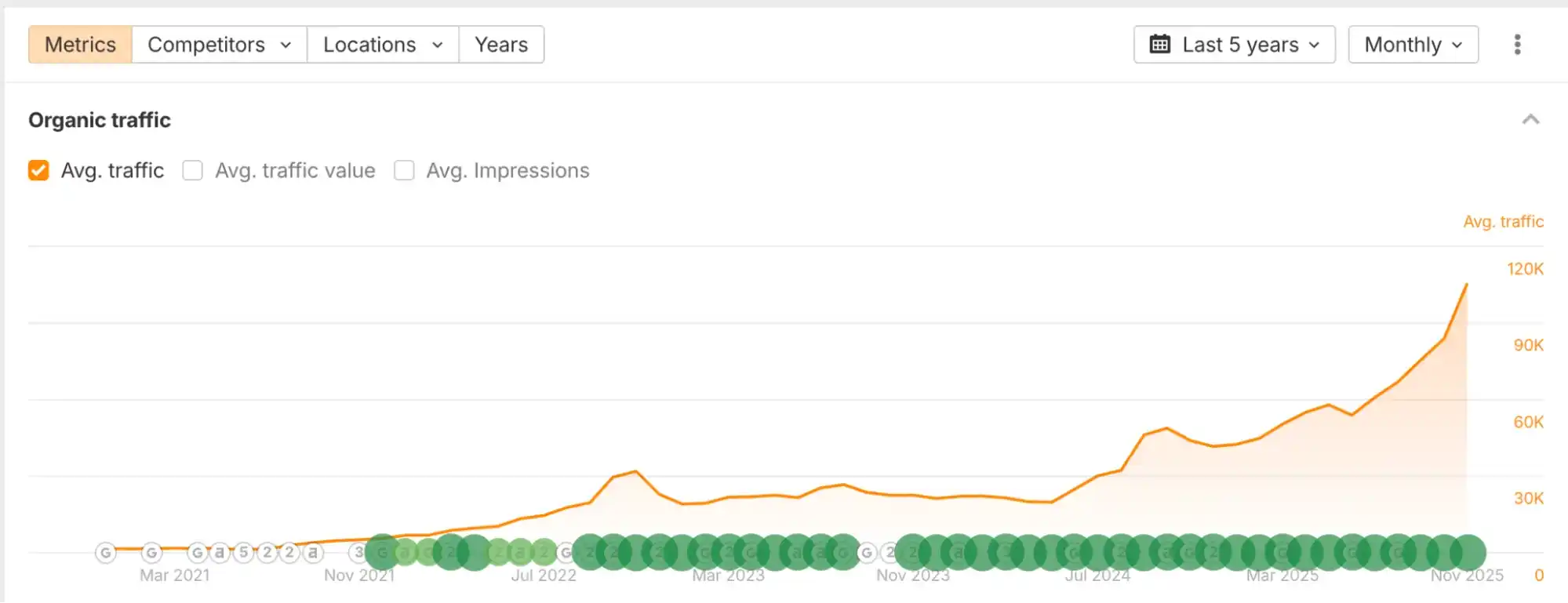
If you’re looking to achieve similar results and turn your B2B business into a real industry leader, feel free to reach out to our B2B SEO agency; we know how to build visibility, traffic, and authority that converts.
9. Shopify SEO: From 0 to 200k/Month Without Backlinks
Based on my experience, in about 90% of SEO cases, if you’re targeting English-speaking markets and working in even a moderately competitive niche, you need at least some budget for link-building. It’s almost non-negotiable.
At Digital World Institute, we usually don’t take on full SEO campaigns without a proper link-building budget, because in most industries, it’s the missing piece that determines how far your growth can really go.
But this time was different. The client, Express Water, came to us not for a long-term SEO partnership but for a one-time optimization project; just to fix the foundation, set up the structure, and make sure everything was technically and strategically correct.
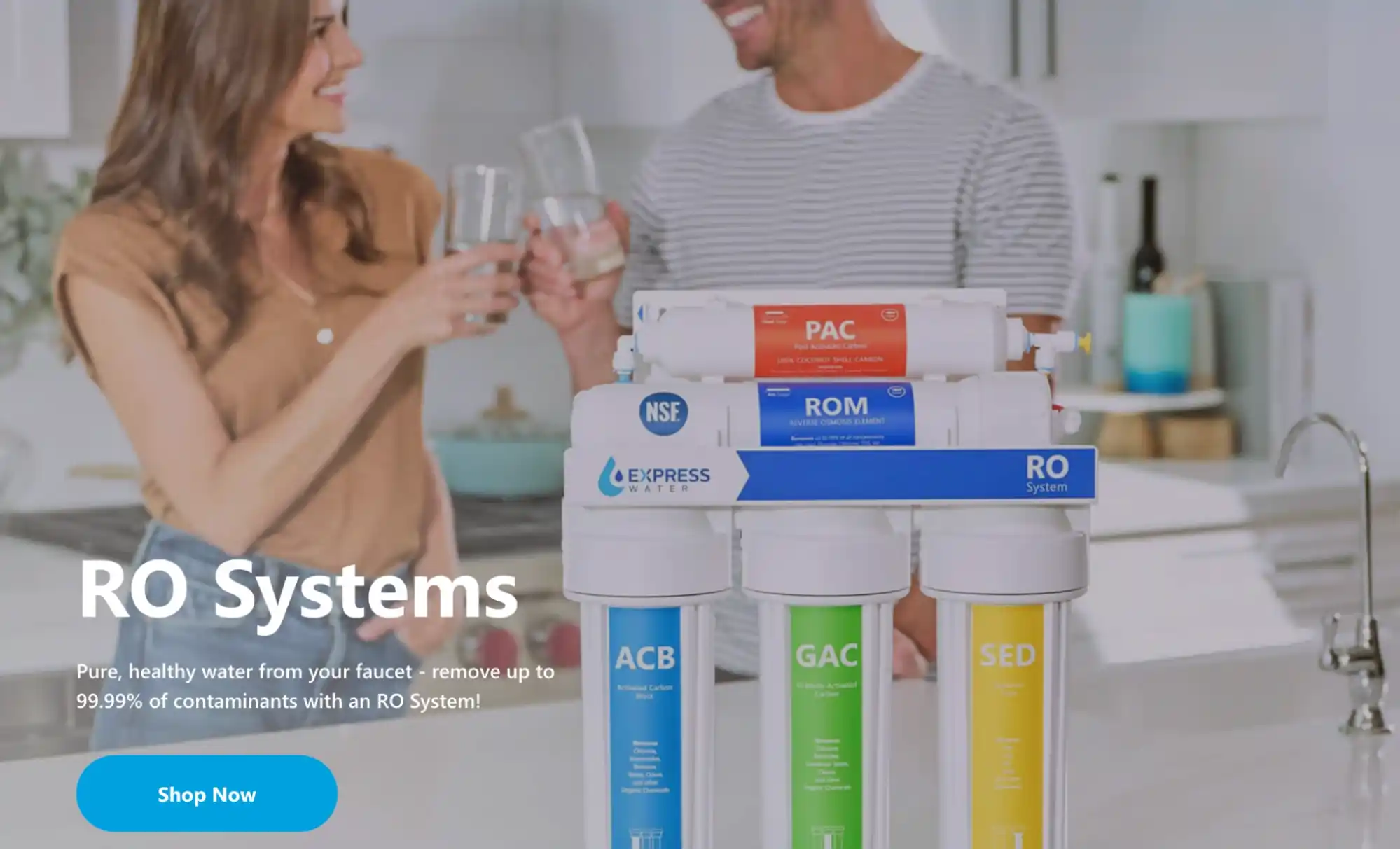
Then something unexpected happened.
Once we implemented the fundamentals: on-page structure, technical SEO, and proper keyword targeting, the site started to move. Steadily, quietly, and without a single backlink.
Within months, we began noticing consistent growth across key pages, and over time, the site went from zero to more than 200K monthly organic visitors: all from pure on-site SEO.

So let’s break down how that happened, and what made this project one of the rare “no-link” success stories in our portfolio.
Insights & Wins
We began this project with a comprehensive market analysis, examining both page-level and domain-level competitors in depth. The goal was to understand not only who was ranking, but also why they were ranking: what kind of content they had, how their site structure appeared, and which keywords were driving the most valuable traffic.
Next, our team conducted detailed keyword research and a full content and keyword gap analysis. That helped us uncover dozens of collection opportunities and hundreds of product-level keyword targets.

We then prioritized everything based on search volume, difficulty, and intent, so every move had a clear direction.
From there, we began optimizing every single product page, crafting unique metadata, implementing primary and secondary keywords, and improving product copy to make it more conversion-friendly.
Our team also made small but important design improvements to enhance user experience and implemented full schema and product markup to maximize visibility in search results.
After setting up all the foundations, we moved into a light SEO maintenance phase, monitoring technical health, fixing common issues as they appeared, and making sure everything stayed clean across Google, Bing, and other platforms.
And then… the numbers started climbing.
Even without backlinks, the site’s organic traffic kept growing month after month.
It’s been almost two years now, and the website consistently generates around 200K monthly organic visitors, all from pure on-site SEO.
In the end, the client laughed and said, “It’s good we didn’t listen to your link-building advice.”
I laughed back, “Yeah, enjoy the free ride while it lasts.”
Honestly, this kind of success without backlinks is rare. But when it happens, it’s a beautiful reminder that strong fundamentals can sometimes outperform everything else.
10. Building PR Backlinks for an eCommerce Dental Store
This case study isn’t about traffic growth or recovery but something we’re passionate about at Digital World Institute: PR-style link building. It’s one of those areas where strategy, relationships, and storytelling meet technical SEO, and when it works, it can completely change a brand’s authority.
This particular project – ProTeethGuard, involved an eCommerce dental store that was already performing decently in organic search but wanted to cement its rankings and strengthen its overall domain authority.

Our goal was to earn top-tier, high-DR backlinks from trusted medical and healthcare publications that would boost the site’s long-term credibility and visibility.
Growth Summary
We started by making sure the brand and its founder looked credible online, because in PR link-building, perception is everything. So first, we optimized the author bio on the client’s website and polished the LinkedIn profile of the company’s CEO to reflect genuine expertise and authority in the dental field.
Next, we created professional contributor and journalist profiles on HARO, Featured.com, and a few other platforms where expert commentary opportunities regularly appear.
Read the Full Story: Dental SEO Case Studies
From there, our team began pitching on behalf of the CEO, offering insights on dental health, product safety, and consumer trends related to oral care; topics journalists and editors wanted to feature.
At the same time, we ran a strategic outreach campaign focused on niche edits and guest posts, earning around 15–20 high-quality backlinks from relevant dental, lifestyle, and medical websites.
These placements helped increase the brand’s domain rating and, more importantly, improved its trust signals in traditional Google search and AI-driven search results.
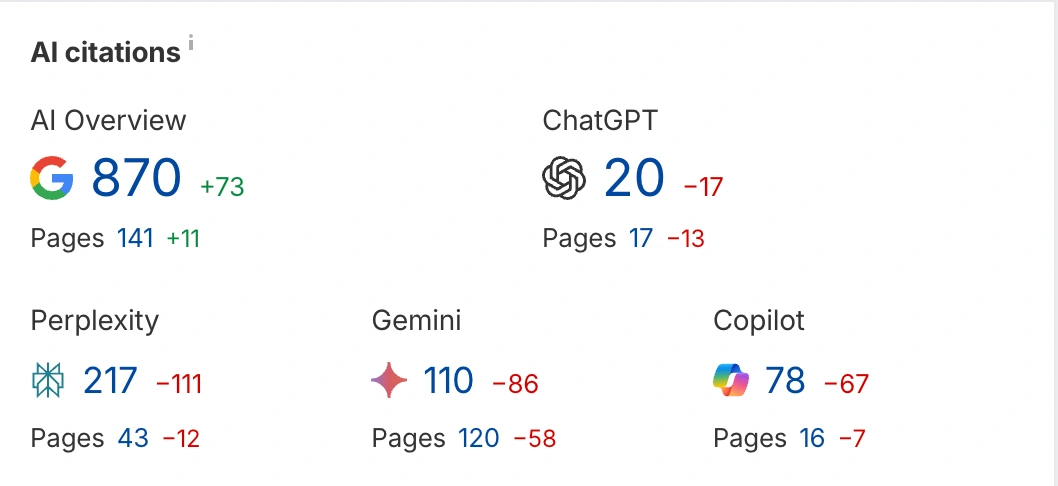
The campaign wasn’t about quick wins; it was about building a credible brand footprint that would last. By the end of the campaign, the site had not only a stronger backlink profile but also real digital authority that Google (and users) could trust.
The Bottom Line
At Digital World Institute, we’ve worked on dozens of eCommerce SEO projects, each with its own challenges, wins, and surprises. But in these top 10 eCommerce SEO case studies, I wanted to highlight the ones that teach something; the real stories with lessons behind the numbers.
Some of them were clear wins, others were hard lessons, but together they show what goes into growing (and sometimes saving) an online store.
We’ve included both our successes and our failures here for a reason, because in SEO, every outcome has something to learn from. If you take even a few insights from these experiences, you’ll already be ahead of most store owners out there.
If you’re ready to get serious about your growth, contact our SEO agency, and let’s move your eCommerce SEO game to the next level with strategy, data, and experience that works.





